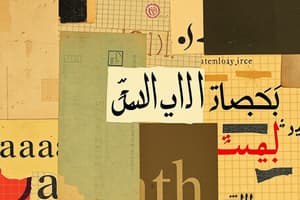Podcast
Questions and Answers
What were the Nabataean and Syriac alphabets used for?
What were the Nabataean and Syriac alphabets used for?
- Writing in modern languages
- Writing Arabic
- Writing in other languages (correct)
- Writing in ancient languages
When was the first recorded text in the Arabic alphabet written?
When was the first recorded text in the Arabic alphabet written?
- Unknown
- 7th century
- 20th century
- 512 (correct)
How many consonant phonemes does Arabic have?
How many consonant phonemes does Arabic have?
- 22
- 28 (correct)
- 30
- 21
What was added to the Arabic alphabet to make it suitable for Classical Arabic?
What was added to the Arabic alphabet to make it suitable for Classical Arabic?
What is the Levantine or Abjadi order?
What is the Levantine or Abjadi order?
Why were extra letters added to the Arabic alphabet when it spread to other countries?
Why were extra letters added to the Arabic alphabet when it spread to other countries?
What were some of the features of the Arabic alphabet that arose due to differences between Qur'anic spelling and the form of Classical Arabic?
What were some of the features of the Arabic alphabet that arose due to differences between Qur'anic spelling and the form of Classical Arabic?
What happened to local adaptations of the Arabic alphabet in non-Arab Islamic areas in the early 20th century?
What happened to local adaptations of the Arabic alphabet in non-Arab Islamic areas in the early 20th century?
What did the Arabic alphabet become capable of writing after dots were added to it?
What did the Arabic alphabet become capable of writing after dots were added to it?
Flashcards
Nabataean and Syriac alphabets - Uses
Nabataean and Syriac alphabets - Uses
The Nabataean and Syriac alphabets were primarily used for writing other languages, demonstrating their adaptability and influence.
First Arabic alphabet text date
First Arabic alphabet text date
The first recorded text in the Arabic alphabet dates back to 512, marking a significant milestone in the development of the writing system.
Number of Arabic consonants
Number of Arabic consonants
The Arabic alphabet has 28 consonant phonemes, providing a strong foundation for representing the sounds of the language.
Arabic Alphabet - Added Dots
Arabic Alphabet - Added Dots
Signup and view all the flashcards
Levantine/Abjadi order
Levantine/Abjadi order
Signup and view all the flashcards
Arabic Alphabet - Extra Letters
Arabic Alphabet - Extra Letters
Signup and view all the flashcards
Arabic Vowel Signs - Origin
Arabic Vowel Signs - Origin
Signup and view all the flashcards
Arabic Alphabet - Local Adaptations
Arabic Alphabet - Local Adaptations
Signup and view all the flashcards
Arabic Alphabet - Writing Numbers using Dots
Arabic Alphabet - Writing Numbers using Dots
Signup and view all the flashcards
Study Notes
The Arabic alphabet evolved from the Nabataean or Syriac alphabets. The first recorded text in the Arabic alphabet was written in 512 and only had 21 letters. The Nabataean alphabet was designed to write 22 phonemes, but Arabic has 28 consonant phonemes. As cursive Nabataean writing evolved into Arabic writing, the writing became largely joined-up, producing more ambiguities. In the 7th century, dots were added to the Arabic alphabet to make enough different letters for Classical Arabic's 28 phonemes. The alphabet then had 28 letters, and so could be used to write numbers. Later, vowel signs and hamzas were added. Some features of the Arabic alphabet arose because of differences between Qur'anic spelling and the form of Classical Arabic that was standardized later. The old alphabetical order is known as the Levantine or Abjadi order. When the Arabic alphabet spread to countries that used other languages, extra letters had to be invented to spell non-Arabic sounds. Since the early 20th century, many non-Arab Islamic areas began using the Cyrillic or Latin alphabet, and local adaptations of the Arabic alphabet were abandoned.
Studying That Suits You
Use AI to generate personalized quizzes and flashcards to suit your learning preferences.





